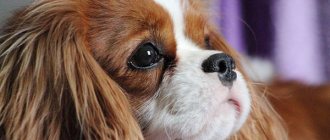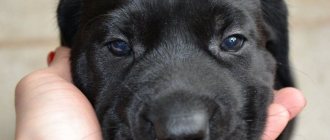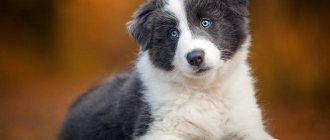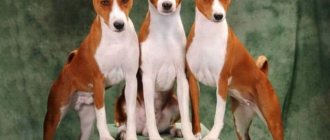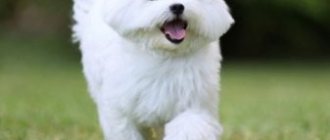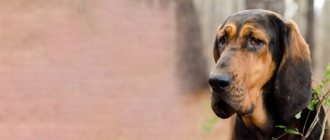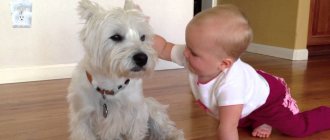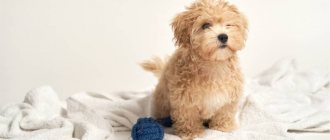Husky is a breed of dog whose attractive appearance and good-natured character have won the hearts of many dog breeders around the world.
Bred for hard physical work and to this day retaining good working qualities and endurance, representatives of this breed today are most often simply faithful companions.
In this article you will get acquainted with a comprehensive description of the Husky breed, which will be useful and interesting for both beginners and experienced dog breeders.
History of appearance
Husky is one of the 14 oldest breeds, bred in northeastern Siberia. The exact time of origin of these dogs is unknown, but scientists suggest that their age is 3 thousand years or more.
Huskies owe their appearance to the Chukchi, who lived on the Arctic coast for many centuries and needed hardy dogs suitable for driving long distances and transporting goods.
In addition, due to the lack of provisions, these dogs had to have a minimal need for food, despite significant physical exertion.
Smart, good-natured, fast and resilient, huskies met all the requirements. These dogs were kept both on the street and in yurts for the purpose of warming small children. The long-term isolation of the peoples of northeastern Siberia determined the long-term preservation of the purity of the breed.
NOTE!
Over time, Americans became interested in the breed, and in 1930 Huskies were recognized by the American Kennel Club, and in 1934 an official standard was adopted. The Canadian Kennel Club recognized the breed in 1939, and individual representatives of the breed were brought to Russia in 1995.
Interesting facts about the breed:
- Husky is a distorted version of the slang "Eski", which the Americans used to call Eskimos.
- Translated from English, “husky” stands for “husky”, since representatives of this breed do not bark, but make hoarse sounds.
- A husky team can travel about 250 km, reaching a speed of 25-35 km/h.
- In 1925, a husky named Balto was the leader of the team that brought diphtheria serum to Alaska, this story is shown in the Disney cartoon.
How much does a Siberian Husky cost?
There are several factors that influence the cost of husky puppies.
This includes the presence of a pedigree, the individual qualities of the baby (appearance, physical fitness, gender), and the status of the parents. It is clear that the cubs of champion dogs - in the case of huskies, not only for exhibitions, but also for sports competitions - will cost much more than the babies of ordinary parents. If you just want to have a friend at home and don’t bother with a show career, your choice is a pet-class puppy. It will cost 20-25 thousand rubles. Most likely, it will be sold without a pedigree, but will that stop you?
Breed-class dogs already cost from 30 thousand rubles. They have all the necessary documents and are quite suitable for breeding work. Some minor deviations from the breed standard are possible.
The most expensive are show class puppies. Such animals fully comply with official standards, have no flaws and are born husky champions. The price for a dog of this class can be more than 60,000 rubles. Buying a baby without the advice and help of an experienced breed expert will be very problematic.
When planning to buy a Siberian Husky, do not chase the low price. On the contrary, such a proposal should alert you. Most likely, ordinary deception or dishonesty is taking place. A husky puppy, taking into account the costs the breeder incurs when breeding this breed, simply cannot be cheap.
Description of the breed
These are medium-sized dogs belonging to the group of working sled dogs. They have a harmoniously built muscular body. They move with an even, easy, effortless gait.
Characteristics of the breed standard:
- the head is medium in size, proportional to the body, the skull is slightly rounded, tapering towards the eyes;
- the muzzle is not too long, the bridge of the nose is straight, the transition from the muzzle to the forehead is clearly defined;
- the eyes are slightly slanted, almond-shaped, the iris can be blue, dark blue, gray or brown, heterochromia is often noted;
- ears are medium size, triangular, set high, tips slightly rounded;
- the nose can be black, brown or gray, depending on the color of the coat;
- scissor bite;
- the chest is wide and deep;
- the back is straight, level;
- The limbs are straight, the thighs are well-muscled, the paws are oval and compact.
The husky's coat is thick and dense, allowing dogs to withstand frosts down to -50-60 °C without problems.
Japanese Husky (Akita Inu)
Japanese Husky is the popular name for Akita Inu. They are one of the 14 oldest indigenous breeds. The Akita Inu's homeland is the Japanese island of Honshu. Traditionally used as watchdogs and hunting dogs. During the Second World War, the Akita was actively used as a service dog, so the owners began to cross it with a German shepherd in order to avoid being sent to the front (at that time, German shepherds were under state protection).
The Akita Inu is a Spitz-shaped dog that looks like a large husky. The Japanese grow up to 70 cm and weigh up to 40 kg. They are distinguished by a harmonious physique and long, dry limbs. The ears are triangular and set high. Almond-shaped eyes are set wide apart. The coat is thick and of varying lengths. The undercoat is abundant and soft. Color can be white, brindle and white-red.
These dogs are known for their calm nature and ability to be trained. A sharp mind allows them to make independent decisions. Akita Inu are prone to self-will and stubbornness. At the same time, they are brave, friendly and loyal dogs.
Character traits
These are affectionate and good-natured dogs that are not prone to anger. They are friendly towards everyone, but if they sense the malevolent intentions of strangers, they can become aggressive.
Huskies do not have a guarding instinct, but with proper training they can be trained to guard the house. However, the maximum that can be achieved from representatives of this breed is to teach them to warn about the visit of strangers; they will not protect property.
These are pack dogs that need constant contact with other animals and people; they cannot be alone. Huskies love people, but do not become attached to one owner. These dogs do not tolerate neglect, since they have always existed on an equal footing with people.
Despite all their goodwill and agreeableness, representatives of this breed have a complex character. They are willful, stubborn, accustomed to making their own decisions and striving for dominance, so it is important from the first days of the puppy in the house to show him that he is not the leader.
During training and education, it is necessary to show patience and perseverance, not allowing the dog to relax and shirk the command.
There are some differences in the character of males and females.
So, the boy’s character is as open and straightforward as possible. Males are not characterized by cunning or any tricks - they openly demonstrate the desire to dominate, are very freedom-loving, independent and can behave aggressively with strangers, defending their leadership and superiority.
Bitches are affectionate and more owner-oriented. They have a soft and calm disposition, they are more obedient and flexible. However, they are very cunning and are able to achieve what they want using a lot of tricks.
Expert opinion
Kozhevin Semyon Kirillovich
Expert dog handler.
When getting a Husky, you should understand that the character of the representatives of this breed largely depends on genetics. Therefore, before buying a puppy, it is important not only to examine it to ensure it meets the breed standard, but also to get to know its parents and find out in as much detail as possible what kind of character they have. What is inherent in all dogs of this breed without exception is a dominant type of behavior, stubbornness and willfulness. They will never obey; you can achieve obedience from them only by showing leadership qualities and winning their trust and favor. These dogs can only be equal companions and partners.
Where to start training a puppy
1. Recognizing your own nickname. The methods are quite simple. Call his name when you call your pet to a bowl of food, and after the baby wakes up, gently stroke him, saying his name. The results will not keep you waiting.
Dad with two puppies
2. Husky, as a pack dog, needs a leader, so from the first hours of being in your home, let it understand who is in charge. Moreover, be careful - even when communicating with members of your family, you must behave as an unquestioned authority, and the puppy must see this. The husky is very smart and will immediately sense if you give in to “slack” in relations with other members of the pack, and the dog perceives all household members this way.
3. Execution of the simplest commands: “Nearby!” and “Come to me!” achieved by the traditional method - with the help of tasty treats and praise.
Many owners are concerned about what to do in cases where the puppy reacts violently to strangers coming into the house: it behaves annoyingly, gets underfoot, begs for food. There is only one answer - ignore it. Don’t stroke, don’t admire (the husky is just waiting for this), but simply don’t notice. The method works flawlessly. The dog, realizing that no one is interested in him, will very soon leave for his place.
Among the general recommendations for raising and training a Siberian Husky, the following can be highlighted:
- do not forbid your pet to communicate with other dogs;
- do not pick up the dog, especially holding it belly first;
- do not tire your husky by performing the same command many times in a row;
- respect your friend and treat him fairly.
Bad habits
Representatives of this breed almost never bark, but they are prone to frequent and prolonged howls.
Why do huskies howl? As a rule, they howl out of anguish and boredom, thus trying to summon members of their flock.
Dogs' desire to slow down their metabolism in order to maintain a feeling of fullness longer determines their habit of swallowing large pieces of food.
If during active growth the pet’s body does not have enough nutrients, the dog tends to eat all kinds of surrounding objects - stones, branches, feces, etc.
Huskies are also prone to escape - even a 1.5-meter fence will not stop them, and because of the dogs’ love of digging holes, not only the landscape of the yard, but also carpets, furniture and other interior items in the house can suffer.
Who is the breed not suitable for?
- These pets are characterized by increased activity . They need to train a lot, walk, play. Therefore, Husky is not suitable for homebodies, sedentary people and elderly people.
- In addition, dogs are strong and fast. In case of escape, an unhealthy person will not be able to catch up with an animal that has not been trained in commands.
- Also, puppies need to be trained for a long time and persistently, accustoming them to the rules of behavior, walking and feeding regime . If the family is not prepared for the fact that at first the dog will not be obedient, neat and restrained, then getting a Husky is not recommended.
Even a teenager can work with representatives of the breed, because they learn quickly and easily. But the dog is best suited to an avid dog breeder who has already kept northern Laikas or similar pets. Although a beginner can practice his training skills with these doggies.
Advantages and disadvantages
Attractive appearance and friendly character are not the only advantages of the husky.
The breed has other advantages:
- good health;
- endurance;
- ability to get along with other animals and children;
- no unpleasant odor;
- sociability;
- independence;
- cleanliness;
- good adaptation to new conditions;
- lack of aggression;
- intelligence and intelligence.
But they also have disadvantages:
- stubbornness and willfulness;
- tendency to dominate;
- lack of protective and watchdog instincts;
- heavy shedding;
- intolerance of loneliness;
- a long and drawn-out howl;
- poor heat tolerance;
- need for communication.
IMPORTANT!
In addition, huskies are very energetic, so they need regular active and long walks and physical activity.
Mixture and comparison
Sled breeds were formed under comparable conditions, which is why there are dogs similar to huskies in color and appearance.
Huskies and huskies
They differ in their scope of use. Huskies are draft breeds bred in the North. Laikas are designed for hunting. Huskies are ready to work around the clock, huskies run out of steam much faster. Huskies are silent, reserved dogs. They express emotions by purring and howling. Laikas are big fans of making noise. Huskies have a powerful constitution, blue eyes and a bushy, fox-like tail. Laikas have an elegant structure, and their tail is curled into a donut shape.
Husky and malamute
Malamutes are designed to carry heavy loads at low speeds. Huskies are used to carry light loads over long distances. They develop high speed. The Malamute is larger and more massive than the Husky. Its average height is 60 cm. It is distinguished by its fluffy coat. The husky's pile fits well to the body.
For a malamute, blue eyes are a breed deviation, for a husky it is the preferred color. The husky has a crescent-shaped tail, while the malamute has a more furry tail. He moves like a fan. Huskies are not characterized by aggressiveness; it is easy to find a common language with them. Malamutes are strong, independent dogs that strive to dominate their owner. They quickly get bored with standard training. The owner must be able to keep the Malamute occupied, otherwise he will come up with entertainment himself.
Northerners are not only tireless workers, but also handsome. This inspires breeders to create unexpected crossbreeds. These include:
- A cross between a husky and a spitz. This mixed breed is called a Pomsky. He is a miniature Spitz-shaped dog with a characteristic husky color. Adults weigh from 3 to 14 kg, the size of the Pomsky is unpredictable. They have a friendly, playful nature and get along well with children.
- A cross between a shepherd and a husky. This beautiful mixed breed looks like a shepherd with blue eyes. Activity and friendly character are the heritage of the husky. Their appearance depends on the predominance of one or another blood. This crossbreed loves to imitate loud noises, including alarms and sirens. Also, these mestizos tend to run away from their owners, so they should not be lost sight of.
- A cross between a Husky and a Labrador. This hybrid looks like a Labrador with blue eyes. Cases of heterochromia are common. The character is dominated by the traits of a Labrador, but in a stressful situation the firmness inherent in a husky appears.
- Another common mixed breed is Akita Inu and Husky. He is a husky with the characteristic Akita coloring.
Mixed breeds are no worse than purebred dogs, but often suffer from genetic disorders. Therefore, when getting such a pet, you need to be prepared for unpleasant consequences.
Photos and description of color options
The husky's coat comes in a variety of colors.
He can be:
- absolutely white - the guard hair and undercoat are white, the nose, eyelids and lips can be pigmented black or brown;
- black and white – the color of the undercoat varies from white to charcoal black;
- gray-white - the main coat is gray, so the undercoat looks like a mixture of silver and beige;
- black – interspersed with white fur on the paws, muzzle, chest and tip of the tail are acceptable, but at least 75% of the fur must be black;
- silver – the color of the main coat varies from light gray to silver, the undercoat can be silver or white;
- copper or chocolate – copper-chocolate colored wool;
- red - rich red fur;
- fawn - a coat of warm pastel color without red, the undercoat is fawn or light cream.
In addition, there are individuals with isabella, tricolor, merle, wolf, sable, black and tan and piebald colors.
Breeding
Before planning offspring, it is necessary to understand whether the animal is suitable for this. If the bitch has impeccable characteristics, then you can begin to select a suitable partner for her.
Expert opinion
Anna Abramenko
An avid dog lover. Experience in veterinary medicine since 2009.
Ask a Question
When determining the candidacy of a stud dog, you need to pay attention to his data - energy, running speed. It is important to analyze the body structure and temperament.
It is necessary to check your pet for possible manifestations of hereditary diseases. Glaucoma and cataracts in his littermates are an alarming fact, signaling the need to remove the animal from further breeding.
Scientists together with dog breeders are developing genetic tests. In the future, they will help identify hereditary diseases. Dogs with deviations in health and appearance should not be allowed to breed. The result is the extinction of the breed's temperament.
If the pair is determined, then it is recommended to organize the mating in an area familiar to the male. This way the boy will feel more confident and calm. There will be no need to explore a new area.
During the mating period, it is important to be doubly attentive to the mood of your pets. You cannot arrange a meeting for dogs prematurely. It should take place no earlier than 20 days after the girl starts estrus. Some pet owners organize multiple mating opportunities.
This should not be allowed within 2 days after the act took place. The sperm is still active. It is also impossible to force a bitch to mate. If she doesn’t show any desire, it means everything worked out the first time.
Expert opinion
Anna Abramenko
An avid dog lover. Experience in veterinary medicine since 2009.
Ask a Question
The process of bearing puppies lasts 9 weeks. 15 days before the birth of the litter, it is important to increase the amount of food the expectant mother eats. During pregnancy, the female should slightly reduce physical activity (but not the time of walking). This will help her quickly return to her original shape after childbirth.
Before the exciting process, the female needs to organize a tight box with a heating pad and a towel. Newborns will have to be placed there. You will need disinfected scissors, a bottle with a pacifier, and a dog milk replacer.
When the birth takes place, the mother needs to be taken outside to relieve herself. Later, she and the cubs will be transferred to a pen created in the warmest room.
Babies are distinguished by their mobility, but open their eyes after birth only 2 weeks later.
Suitable for living in an apartment or outdoors?
Being not very large dogs, huskies are suitable for apartment living, but only if they are provided with the necessary level of physical activity . It is important to remember that these are not indoor dogs; they need walks and active games.
You can keep these dogs in the fenced area of a private house by equipping a spacious enclosure or kennel.
Due to the peculiarities of their coat, representatives of this breed can live outside without problems even in the cold season.
Huskies do not tolerate heat well, so it is necessary to equip a canopy under which the pet can hide from the sun.
Conditions of detention
A private house with a large yard is more suitable for keeping these dogs. They can be left outside even in winter. It is necessary to properly equip the closed enclosure. To prevent your pet from digging or jumping over the net, you need to provide for all this.
Siberian Husky
Beginning dog breeders often have a question: is it possible to keep a husky in the city? They feel best in the wild, but if several conditions are met, they adapt to life in an apartment.
- There must be one family member at home so that the pet does not feel lonely. If possible, you need to get a second dog.
- It is necessary to walk the dog for a long time. She must be tired so that there is no desire to be naughty at home. Some people who are thinking about getting a husky give up the idea when they find out how much walking they need to do. Not everyone has 4-5 hours of free time.
- You need to leave your pet toys and chewing bones. It is just not recommended to give soft toys.
Attitude towards children and does he get along with other pets?
Huskies get along well with children, quickly find a common language with them and play with pleasure. Many dogs become so attached to children that they strive to accompany them everywhere, not leaving them even during sleep.
But, if the child is very small, you should not leave him alone with the dog, since due to the rather large size and irrepressible energy of the husky, he can accidentally injure the baby.
Huskies get along well with other animals, especially if we are talking about pets that grew up with them. Problems can only arise with neighbor's dogs and other people's cats, which huskies, despite the fact that they are not hunting dogs, perceive as objects of hunting.
How do dogs get along with cats?
A husky can get along with cats only if they grow up together from childhood . They are even able to make friends. Otherwise, certain problems will arise, although with proper upbringing the dog will restrain its hunting instincts.
Due to the fact that dogs are pack animals, they are accustomed to living off their own feeding. Their habit of killing small animals for survival has still not been eliminated.
Behavior with other pets
All fur-bearing animals, birds, and livestock can become the object of sudden hunting. Huskies love to track game for food. Therefore, it is better not to keep this dog and other pets in the same house. If the dog lives on a farm, then all animals must be well fenced.
Rules of care
The main difficulty in caring for huskies is their coat during the molting period. Otherwise, these dogs only need hygiene procedures, which must be carried out regularly.
Wool and bathing
To avoid the formation of tangles, the coat should be combed every 2-3 days, and daily during shedding.
You should give your pet a full bath no more than once a quarter, but you need to wash its paws after every walk if we are talking about apartment living.
NOTE!
Representatives of this breed cannot be cut.
Ears
Once a week, inspect and, if necessary, clean with a cotton swab from accumulated wax and dirt.
Claws
If the nails do not grind down on their own during walks, they need to be trimmed once every 3-4 weeks with a guillotine nail clipper.
Eyes
Inspect daily, wipe with a damp cotton pad, removing minor discharge and secretions that have accumulated overnight.
Teeth
Brush daily with a special brush and paste, give special treats and toys to chew on to help cleanse teeth of plaque and stones.
Maintenance, care and nutrition of huskies
Siberians suffer from limited space, so it’s unlikely that anyone will be able to make a “sofa cushion” out of a husky. She needs constant movement, long distance walks, and physical exercise.
In order to direct the inexhaustible energy of a pet living in an apartment in the right direction, you will need to fully utilize his free time, otherwise the interior of the apartment will noticeably suffer.
Husky with bad upbringing
When keeping a dog on the territory of a country house, it is necessary to equip a large enclosure. Staying outside is a common thing for huskies, because they come from northern regions, so they are not afraid of frost.
To arrange a spacious enclosure, you should not use a chain-link mesh. A born hunter will turn her into rags. It is advisable to make fences for the enclosure from wire 0.5 mm thick.
Since dogs dig the ground and dig tunnels, it is recommended to make the floor of the enclosure from stones. Huskies love to travel, so if the area is not fenced off with a high fence, the dog may not be found. Your four-legged friend needs to be walked for a long time.
Husky diet
The number of feedings depends on the age of the dog:
| Age | Number of feedings |
| 2 months | 6 |
| 4 months | 5 |
| Six months | 4 |
| 10 months | 2 |
| 1 year and older | 1–2 times (depending on load) |
Until the puppy reaches 10 months, it is allowed to feed puppy food. Adults need balanced food that is designed for active breeds. The best food for a dog is dry food or special canned food of good quality. Plain food contains a high proportion of starch, which is harmful to this breed.
Even when feeding high-quality formulas, sometimes it is necessary to make changes to the Husky's diet, so dog breeders strongly recommend monitoring the health of the pet while feeding dry food.
It is very difficult to organize a natural, balanced diet so that the dog has enough vitamins and microelements. The majority of the diet should be meat, which can be fed raw or lightly scalded. Siberian Huskies prefer rabbit, beef, and turkey. Lamb and pork meat should not be given. Chicken can cause allergies.
All vegetables are healthy except potatoes. Twice a week it is recommended to give egg yolk, mixing it into the porridge. For full development, a dog needs vitamin E, so it is necessary to add vegetable oil or fish oil to its food.
No matter how varied natural nutrition is, you cannot do without vitamin complexes. Your veterinarian should advise you which vitamins to give your pet.
Caring for your pet involves combing its fur, especially when shedding occurs. It is important to monitor the condition of your teeth. To maintain the enamel always in a snow-white appearance, it is necessary to clean off plaque in a timely manner. The procedure can be carried out independently or by visiting a clinic.
Huskies do not need water treatments, as this can cause dog odor and make them smell bad. A feature of wool is self-cleaning. Frequent washing will lead to an imbalance between the sebaceous glands.
The well-being and life expectancy of your four-legged friend will depend on proper care and good living conditions.
Life expectancy and major diseases
Huskies are hardy dogs, but the selection process has had a negative impact on their health and has made the breed prone to:
- inversion of the eyelid;
- retinal atrophy;
- cataracts;
- dystrophy of the ocular cornea;
- glaucoma;
- hypertension;
- testicular tumors;
- perianal adenoma;
- paralysis;
- atopic dermatitis;
- diabetes mellitus;
- pathologies of the thyroid gland;
- epilepsy;
- degenerative myelopathy;
- depigmentation of the skin and integument and nose;
- joint dysplasia;
- orchitis;
- food allergies.
Specific diseases of this breed include juvenile laryngeal paralysis, eusinophilic oral granuloma and spastic colitis.
Some individuals experience an allergic reaction to certain medications, especially analgesics and sedatives.
On average, huskies live 12-15 years, but in the absence of serious pathologies and proper care, their life expectancy can be even 20-25 years.
Health and treatment
Huskies were bred in a harsh region and were subjected to severe physical stress. This provoked the development of physiological characteristics. Therefore, high blood clotting and an enlarged heart are not considered pathologies for them.
Like all dogs, Siberians can get fleas. It is difficult to get rid of them, given the thick fur. Owners should check their dog's coat weekly.
Pets, especially males, are susceptible to hereditary diseases, such as:
- diabetes;
- disruption of the thyroid gland and musculoskeletal system;
- pathologies of the nervous system, heart muscle;
- dermatitis.
Diseases of the visual organs are common - from cataracts to entropion.
When do your ears stand up?
Newborn Husky puppies have floppy ears, which must rise over time for the dog to meet the breed standard.
At what age do husky ears stand up? As a rule, this occurs at 1.5-2 months, but in some individuals the ears rise only at the age of 6 months.
Ears may fall off during teething or after vaccination.
If your pet's ears have not stood up by 6 months, you should reconsider his diet or glue the ears yourself or seek help from a veterinarian or groomer.
History of the Siberian Husky breed
The Siberian Husky is a dog that has been living next to humans for many centuries. It was bred by the indigenous inhabitants of the Russian Far North. The Chukchi desperately needed a dog that could cover long distances and transport people and cargo from seasonal hunting grounds to camps. Harsh climatic conditions had a decisive influence on both the formation of the animal’s structure and its character.
Husky with eyes of different colors (Heterochromia)
The spread of the breed beyond its centuries-old habitat began actively in the 20th century. The husky's endurance, ability to work harmoniously in a harness for a long time and good speed were appreciated on the American continent. Alaskan mushers increasingly began to purchase these dogs to participate in sled dog racing. The greatest fame was gained by Leonard Seppala's team, led by the legendary Togo, which did not give up the palm for several years in a row. But this musher and his dogs entered the history of mankind primarily because it was his Togo, leading a team, who covered a huge part of the path of the famous dog relay of 1925, delivering anti-diphtheria serum to Nome. A small town in Alaska, cut off from the world by miles of snowy desert, is overwhelmed by an epidemic of a deadly disease. It was not possible to get to it quickly and safely by conventional means: unfavorable weather and natural conditions were not suitable for air or land transportation. And then people turned to the faithful huskies for help. The sled relay covered more than a thousand kilometers in a record five days, and the city's population was saved. The best dogs, led by Togo, covered 146 km - the maximum distance. The dogs walked eighty kilometers on the ice of Norton Bay in forty-degree frost in a snowstorm. Such a feat became possible only thanks to the instinct, courage and endurance of the leader of the pack.
The last team in this relay were the dogs of Gunnar Kaasen, led by Balto, who got all the glory. In memory of these events, grateful people erected a monument to this dog in New York. Statues of Togo and Balto greet guests at the entrance to ClevelandMetroparksZoo, and when visiting the museum in the small Alaskan town of Wasilla, you can see Togo's embalmed body. To commemorate that incredible relay, Alaska hosts an annual multi-day sled dog race.
Husky puppy
Further development of the breed took place on the American continent, since in the 30s in the USSR the selection of sled dogs was considered unpromising.
In the USA, for a long time, special attention was paid to the sports component. The crossing of Siberian huskies with native sled dogs of Alaska led to the emergence of mixed breeds, which became much more successful than huskies in racing competitions, although they did not receive recognition from international organizations - the mixed breeds turned out to be very diverse.
A new direction in the history of the breed - exhibition - began from the moment when E. Seely and L. Demidoff first presented a bright black and white dog with blue eyes to the judges. It was since the 70s of the last century that huskies increasingly appeared as a domestic companion dog, quite suitable even for keeping in an apartment.
The return of the breed to its historical homeland, Russia, occurred in the 90s. The first dogs were imported from Belgium and the Czech Republic in 1995, and after five years the number of purebred puppies reached one and a half hundred.
How to feed?
You can feed huskies both natural products and industrial food, the main thing is not to mix both types and make sure that the food is balanced and includes all the necessary macro- and microelements.
Energetic and active huskies need protein food - the diet should contain at least 70% meat, but only dietary meat.
Also, when feeding the dog naturally, it is necessary to give:
- offal and cartilage;
- cereals;
- sea fish;
- low-fat fermented milk products;
- egg yolk;
- vegetables;
- fruits and greens.
It is forbidden to feed your pet:
- pork, lamb;
- sweets;
- pasta and bakery products;
- smoked meats, pickles, marinades;
- lard;
- fried, spicy foods;
- milk;
- chicken protein;
- bones;
- nuts;
- potatoes;
- raisins, grapes.
Among industrial feeds, you should choose those with a minimum of carbohydrates but a lot of healthy fats.
The most popular and suitable food for these dogs:
- Nutra Gold;
- Advance;
- Purina Pro Plan (Sensitive Salmon, Medium Robust Health, Medium Robust, Medium Puppy Sensitive);
- Royal Canin;
- Happy Dog (Maxi Baby, Nature Croq).
List of suitable nicknames
The pet's name must be chosen based on the animal's temperament.
Options for males:
- Siberia, Nero, Thunder, Zeus, Diamond, North;
- Fog, Buran, Shine, Nord.
Suitable nicknames for girls:
- Winter, Blizzard, Taiga, Elsa, Snowy;
- Umka, Zvezda, Bagheera, Yuna, Tina.
This is interesting: The most popular nicknames for husky boys and girls
Who should start one?
Huskies are hyperactive and energetic dogs that require long walks every day. Therefore, they will become excellent pets for people leading an active lifestyle.
IMPORTANT!
These dogs are not suitable for people who are insecure and have no experience in raising and training dogs. They need an owner with a strong-willed, strong character, capable of constantly proving his leadership and authority.
Education and training
When it comes to raising and training a Siberian Husky, it is important to consider that these dogs are working dogs by nature, but not service dogs. Experts consider representatives of the breed to be good and easy to train animals. But they will obey only a recognized leader and owner - you must become an indisputable authority for the pet.
Raising a puppy should be based on two main principles - rigor and fairness. The carrot and stick policy is unacceptable. An overly gentle attitude will spoil the baby and he will “sit on your head”; cruelty will embitter the animal, which will definitely take revenge on you if necessary.
You can start training and training your dog from the age of three months. The Siberian Husky is very intelligent, and if you fail to interest him, it will be difficult to achieve results. And not because the animal does not understand you - no, he is simply not interested. The greatest effect is achieved by the training process in the form of a game. These dogs are very sensitive to the manner in which commands are given, so correct intonation is very important. You must speak calmly, confidently and clearly. Although at the same time, many owners of dogs of this breed note that huskies respond better to requests than to orders. In any case, every owner is looking for his own way to the heart and mind of his pet.
Raising any dog is impossible without a system of rewards and punishments. There are several husky misbehaviors that should be stopped immediately:
- aggressive behavior towards the owner;
- unreasonable hostility towards other dogs;
- actions that could harm the animal itself.
The best method of punishment for a Siberian Husky is to demonstrate its strength and advantage. To do this, simply grab the animal by the withers, press it to the floor and hold it until the dog stops resisting and becomes quiet. Beating as a method of education is unacceptable.
It's easier with incentives. Always praise your dog for every correct action. If you are working with a puppy, praise can be reinforced with a piece of treat. The intonation should be different from the tone in which you give commands, but do not show unnecessary emotions - huskies cannot stand high, shrill intonations.
How to choose a puppy? Boy or girl?
Before purchasing a puppy, it is necessary to carefully examine it to ensure that it is healthy and meets the standard.
A small husky should have a shiny coat without dandruff, clean skin without rashes or scratch marks, clean, clear eyes, a scissor bite, and a chest of moderate width.
Unpleasant odor from the ears, discharge from the nose or eyes, a swollen belly, or lack of appetite are signs that the puppy has some kind of disease.
When choosing the gender of your future pet, you should take into account that males behave calmer, they are more resilient and strong, but due to their strong stubbornness and willfulness, they are less amenable to training. Girls, in turn, are more obedient and learn better, but during estrus they lose their ability to work.
Features of hunting
The breed's getter instinct is well developed. Quality passed down from Aboriginal ancestors. Husky loves to chase ungulates.
The dog is able to quickly pick up the scent, drive away roe deer and wild sheep. Neat build, agility, help not to drown in the snow. Endurance and energy allow him to chase game for a long time, exhausting it.
The pet lets its owner know with its voice and howl that it has tracked the animal. This is reminiscent of hunting with huskies. However, huskies have greater agility, tenacity, and are able to calculate the actions of animals in advance.
Nurseries in Russia and the CIS
Huskies are popular dogs, so it’s not difficult to find a kennel that specializes in breeding the breed and selling purebred puppies:
- “Husky Club”, Moscow region, Minino village;
- “Volych”, Nizhny Novgorod;
- “Snow Angel”, Volgograd;
- “Lupin's Flock”, Moscow region, Drakino village;
- Erzulie Freda, Tula;
- Sherwoods Melody, Belarus, Minsk;
- “Childhood Dream”, Belarus, Minsk;
- Asgardfrost's, Ukraine, Donetsk;
- Chamonix Deus, Ukraine, Kherson;
- Emerald Mascot, Ukraine, Donetsk.
CAREFULLY!
Despite the lower cost, you should not buy a puppy on the market or through an advertisement - there is a high risk of purchasing a sick or non-purebred pet.
Reviews
Yulia Petrenko: “I started training when the puppy was 2 months old. Now he is 1 year old. Executes even the most complex commands, catching them on the fly. The pet is smart, intelligent, and curious. But it is important to be able to explain to the four-legged what is good and what is bad.”
Evgenia Korotkova: “Husky, my favorite breed. I have never met smarter, more reliable, more beautiful creatures than these. With good upbringing, a furry friend does not cause difficulties and does not let the owner down. I know from personal experience. Confirms the facts and description of the Siberian breed.”
Eduard Kuzmin: “A dog for energetic, positive people. She will not get along with a passive person and will try to escape. Requires entertainment, many hours of walks.”
Even a beginner in this matter can train a Siberian Husky. The main thing is to gain respect from the four-legged one. Then he will become not just the pride of the owner, but a true friend.
Male
The boy's Husky breed also has its own character traits, judging by the description from primary sources. Males are slightly larger than females, more stubborn and independent. Males are reserved, filled with self-esteem, and sometimes compete with their own kind. Loving to chase supposed prey.
Puppy weight and sizes from 1 to 12 months
The table shows the average size of a husky puppy by month.
| Husky puppy age | Weight | Height |
| 1 month | Weight - about 3 kg | Height - not measured |
| 2 months | Weight - 5-6 kg kg | Height - 31 cm |
| 3 months | Weight - 11.5 kg | Height - 43 cm |
| 4 months | Weight - 12-15 kg | Height - 47-48 cm |
| 5 months | Weight - 13-18 kg | Height - 48-52 cm |
| 6 months | Weight - 15.5-20.5 kg | Height - 49-54 cm |
| 7 months | Weight - 16.6-24 kg | Height - 51-57 cm |
| 8 months | Weight - 17.5-25 kg | Height - 53-58 cm |
| 9 months | Weight - 18.5-26.5 kg | Height - 53-58 cm |
| 10 months | Weight - 20-27 kg | Height - 53-58 cm |
| 11 months | Weight - 21-27.5 kg | Height - 54-59 cm |
| 1 year | Weight - 23-28 kg | Height - 54-59 cm |
Height and weight
The weight of males should be from 20.5 to 28 kg, and that of females from 15.5 to 23 kg.
Height at the withers in adult representatives of the breed should be from 53.5 to 60 cm in males and from 50.5 to 56 cm in females.
The neck circumference of a husky is from 43 to 51 cm.
Considering that the body format of these dogs is only slightly stretched, the length of their body should exceed the height at the withers by no more than 1-3 cm.
Expert opinion
Tolkachev Andrey Mikhailovich
veterinarian
“The Husky's weight must be in the correct proportion to weight and within the standard range. Not all owners of these dogs feed their pets correctly and at the same time do not provide them with the necessary exercise. As a result, the husky quickly gains excess weight, which negatively affects not only his appearance, but also his health. "Obese dogs are more susceptible to diseases such as diabetes or heart disease, and for female dogs, being overweight can cause complications during pregnancy and childbirth."
Main features
Dogs of this breed have soft fur and a calm character , but the most famous feature is their very beautiful, ice-blue eye color.
Husky eyes can come in different shades, but blue is the most common.
Huskies are short animals with thick hair. The tail is curved into a ring. The color can be varied :
- Grey.
- White and grey.
- Brown.
- White and black.
- White.
